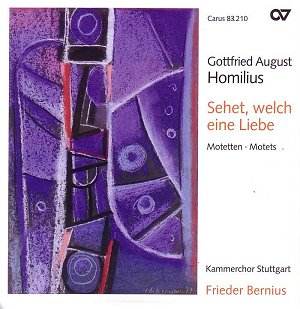In the first half of
the 17th century the motet was one of
the main genres of liturgical music
in Protestant Germany. Many composers
including Heinrich Schütz wrote
pieces to be used in service. But in
the second half of the century relatively
few motets were written. In the 18th
century the motet remained an organic
part of the liturgy however at that
stage the Church was quite happy in
general to use compositions dating from
the 16th or early 17th century.
In the first half of
the 18th century we see a gradual renaissance
of the motet. Georg Philipp Telemann,
for instance, wrote a number of them
which could be used in service. Bach's
motets, though, were not written for
liturgical use, but for special occasions,
like funerals.
A composer who wrote
a considerable number of motets was
Gottfried August Homilius. He was born
in Rosenthal in Saxony, and received
his main musical education in Dresden,
where he obtained a position as organist.
In 1735 he went to Leipzig to study
law. It must be during this time that
he became a pupil of Johann Sebastian
Bach. In 1742 Homilius secured the position
of organist at the Frauenkirche in Dresden.
In 1755 he succeeded Theodor Christian
Reinhold as cantor of the Kreuzkirche
and musical director of the three principal
churches in Dresden, a position he held
until his death.
Today Homilius is mainly
known among organists because of his
many chorale preludes. But he also composed
at least ten oratorios and about two
hundred cantatas. And then there are
the more than sixty motets, which were
hardly ever performed until a complete
edition was published in 2000. Most
motets on this disc are recorded here
for the first time.
The motets by Homilius
reflect their liturgical purpose. Most
of them are rather short, and all of
them - at least those recorded here
- are on texts from the Bible, either
the New Testament or the Book of Psalms.
The inclusion of chorales in about half
of the motets on this disc also reflects
their liturgical use. In the liner notes,
Uwe Wolf characterises the use of chorales
as a way to make a connection between
'art' and 'rite'.
These motets are written
in the musical language of the period
broadly falling between baroque and
classicism. They are often homophonic,
although Homilius does make use of counterpoint
now and then. But they are also strongly
connected to the past, both in the use
of chorales and the writing for double
choir.
There is quite a lot
of variety here. Some of the motets
contain elements of dialogue. In the
first of the programme, 'Da es nun Abend
ward' (Matthew 20, 8), the basses play
a solo role on the third line where
the lord of the vineyard is quoted as
saying: "call the workers and give them
their pay". And in 'Ihr sollt nicht
sorgen und sagen' (Matthew 6, 31-32)
the basses state "you should not worry
and say", after which the other three
voices sing "what are we to eat?"
The same kind of procedure
is followed in the motet 'Machet die
Tore weit' (Psalm 24, 7-10): choir I
sings "Who is the King of Glory?" and
choir II answers: "It is the Lord, strong
and mighty".
In 'Was hast du, Mensch'
Homilius makes use of the two choirs
to mark the central line in the motet:
on the words "was rühmest du dich
denn" (why do you boast) the two choirs
join, sometimes singing unisono.
In 'Die mit Tränen
säen" (Psalm 126, 5-6), the contrast
between the first two lines (They who
sow with tears / will reap with joy),
is underlined by the use of sighing
figures in the first line and a melisma
on the word "Freuden" (joy) in the second.
Words or phrases are
singled out in several ways, by joining
two choirs as in 'Was hast du, Mensch',
or repetition of words like 'Glück'
in 'Wünschet Jerusalem Glück',
or by setting words to long-held notes,
like 'ruhen' in 'Selig sind die Toten'
and 'Arbeit' in 'Unser Leben währet
siebenzig Jahr'. Very effective is the
illustration of the last lines of that
motet: "For all flees quickly away as
on swift wings".
In the booklet Frieder
Bernius tells how he became acquainted
with these motets, and how much he was
impressed while studying them. Having
heard this recording I can fully understand
this. These motets are outstanding compositions,
and a very important addition to the
choral repertoire of the 18th century.
The impressive quality
of the compositions goes along with
an equally impressive performance by
the Kammerchor Stuttgart. The clarity
of the choral sound, the immaculate
phrasing and articulation, perfect intonation
and the fine shaping of the musical
lines as well as the way the text is
treated - these characteristics make
this definitely one of the finest choral
releases of recent times. I strongly
recommend this disc and express the
hope that Frieder Bernius and his outstanding
choir will give us the joy to hear more
of Homilius's motets.
Johan van Veen







